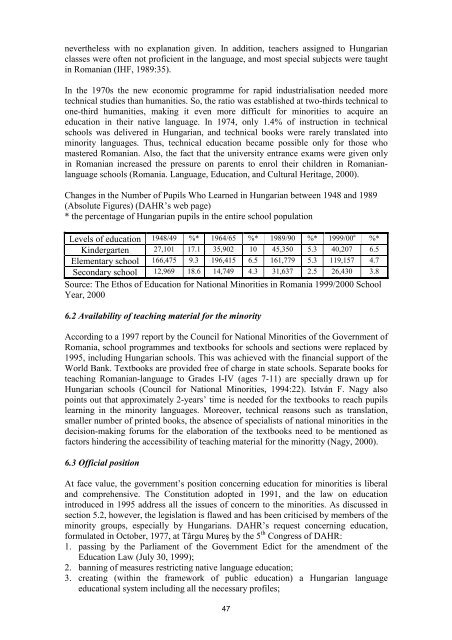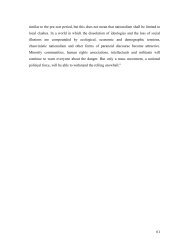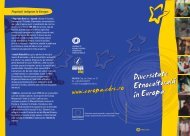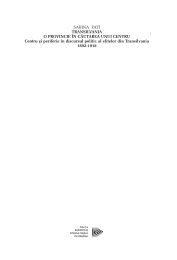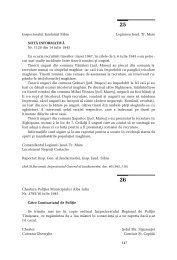Southeast Europe
Southeast Europe
Southeast Europe
You also want an ePaper? Increase the reach of your titles
YUMPU automatically turns print PDFs into web optimized ePapers that Google loves.
nevertheless with no explanation given. In addition, teachers assigned to Hungarian<br />
classes were often not proficient in the language, and most special subjects were taught<br />
in Romanian (IHF, 1989:35).<br />
In the 1970s the new economic programme for rapid industrialisation needed more<br />
technical studies than humanities. So, the ratio was established at two-thirds technical to<br />
one-third humanities, making it even more difficult for minorities to acquire an<br />
education in their native language. In 1974, only 1.4% of instruction in technical<br />
schools was delivered in Hungarian, and technical books were rarely translated into<br />
minority languages. Thus, technical education became possible only for those who<br />
mastered Romanian. Also, the fact that the university entrance exams were given only<br />
in Romanian increased the pressure on parents to enrol their children in Romanianlanguage<br />
schools (Romania. Language, Education, and Cultural Heritage, 2000).<br />
Changes in the Number of Pupils Who Learned in Hungarian between 1948 and 1989<br />
(Absolute Figures) (DAHR’s web page)<br />
* the percentage of Hungarian pupils in the entire school population<br />
Levels of education 1948/49 %* 1964/65 %* 1989/90 %* 1999/00 a<br />
%*<br />
Kindergarten 27,101 17.1 35,902 10 45,350 5.3 40,207 6.5<br />
Elementary school 166,475 9.3 196,415 6.5 161,779 5.3 119,157 4.7<br />
Secondary school 12,969 18.6 14,749 4.3 31,637 2.5 26,430 3.8<br />
Source: The Ethos of Education for National Minorities in Romania 1999/2000 School<br />
Year, 2000<br />
6.2 Availability of teaching material for the minority<br />
According to a 1997 report by the Council for National Minorities of the Government of<br />
Romania, school programmes and textbooks for schools and sections were replaced by<br />
1995, including Hungarian schools. This was achieved with the financial support of the<br />
World Bank. Textbooks are provided free of charge in state schools. Separate books for<br />
teaching Romanian-language to Grades I-IV (ages 7-11) are specially drawn up for<br />
Hungarian schools (Council for National Minorities, 1994:22). István F. Nagy also<br />
points out that approximately 2-years’ time is needed for the textbooks to reach pupils<br />
learning in the minority languages. Moreover, technical reasons such as translation,<br />
smaller number of printed books, the absence of specialists of national minorities in the<br />
decision-making forums for the elaboration of the textbooks need to be mentioned as<br />
factors hindering the accessibility of teaching material for the minoritty (Nagy, 2000).<br />
6.3 Official position<br />
At face value, the government’s position concerning education for minorities is liberal<br />
and comprehensive. The Constitution adopted in 1991, and the law on education<br />
introduced in 1995 address all the issues of concern to the minorities. As discussed in<br />
section 5.2, however, the legislation is flawed and has been criticised by members of the<br />
minority groups, especially by Hungarians. DAHR’s request concerning education,<br />
formulated in October, 1977, at Târgu Mureş by the 5 th Congress of DAHR:<br />
1. passing by the Parliament of the Government Edict for the amendment of the<br />
Education Law (July 30, 1999);<br />
2. banning of measures restricting native language education;<br />
3. creating (within the framework of public education) a Hungarian language<br />
educational system including all the necessary profiles;<br />
47


